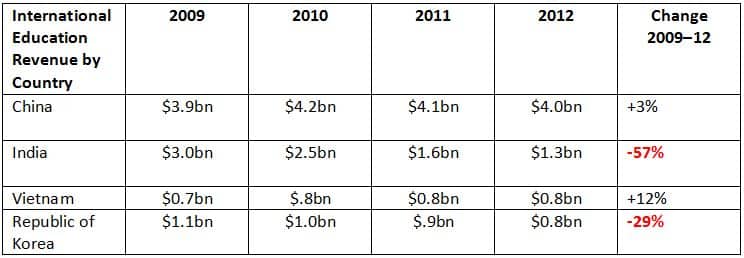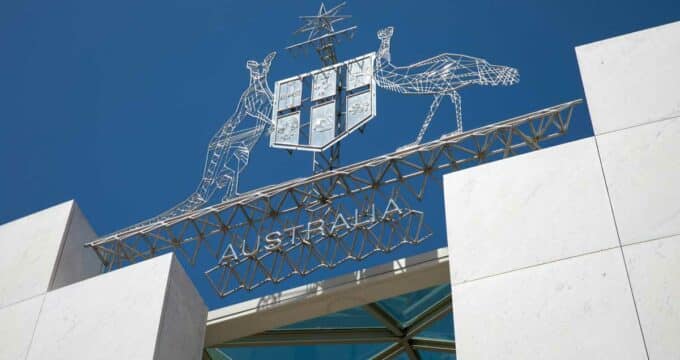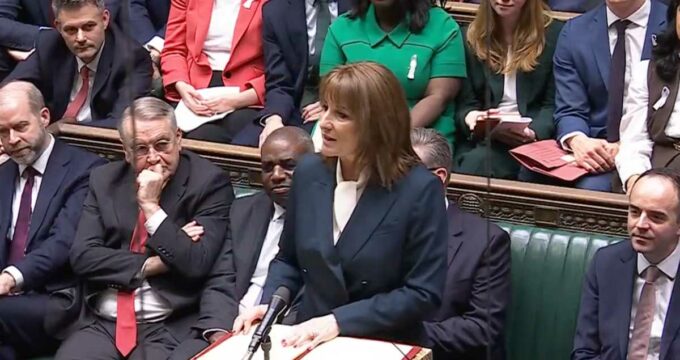Mixed signals continue regarding the extent of Australia’s international education recovery
There is good news and less good news when we look at the Australian international education market. On the one hand, education remains the country’s biggest service export sector, having brought in roughly AUS $15 billion in 2012. It took over from tourism in this position in 2007–08, and even surpassed gold for a brief time in 2009–10. (Overall, Australia’s current top four exports are iron, coal, gold, and education, respectively.) But 2009 remains the peak for Australia when it comes to international student enrolments, and as Ray Fleming writes on The Education Blog:
“It’s still a big drop from the AUS $17.6bn high of 2009 … in fact, it’s the third year of falling revenue from international students.”
Vocational sector hardest hit
Mr Fleming points out that the hardest hit in terms of enrolment declines are VET (vocational training) schools, with a drop of 50% over the past three years. By contrast, the nearly AUS $0.5 billion Australian universities have lost since 2009 represents only a 5% drop. It doesn’t seem like the VET sector is going to fare much better this year. The Australian notes that VET enrolments are down 11.7% for 2013 till May and commencements down 4.9%. As ICEF Monitor reported earlier this year, the Knight Review recommendations adopted by the Australian government are believed by many to be excluding the VET sector. Clare Field, the CEO of Australian Council for Private Education and Training (ACPET), which represents more than 1,000 VET, English, and HE providers, has said the Australian government needs to extend visa and immigration reform to the VET sector to protect it and the health of the overall system:
“A key recommendation of the 2011 Knight Review is that streamlined visa processing measures be introduced beyond the university sector. This delay is compounding uncertainty for providers and prospective students, with negative effects for the sector and the economy.”
Ms Field has said of the government’s delay in extending the Knight Review recommendations to the VET sector:
“Good providers are going to the wall and Australia is losing substantial export income … the industry is on its knees as a result of government inaction.”
Indian student numbers continue to drop
Mr Fleming notes that a good portion of the declines stem from Indian students, who in 2012 contributed 57% less revenues to the Australian education system than they did in 2009. This is the table Mr Fleming presents:

- 60% of Indians would like it if India's government and society worked more like Australia’s - similar to the proportions saying they wished them to be more like those in Japan and Singapore. Only the United States ranked better, at 78%.
- 75% of Indians view Australia as a good place to be educated, second only to the United States (83%).
- 62% of Indians think Australia remains a dangerous place for Indian students. However, 53% said it is safer than it was a few years ago … and 64% said any country could be dangerous for Indian students who are not careful.
English-language sector continues to improve
The Australianreports that:
“Even though overall higher education numbers for the year to May were down 2.6% on 2012, commencements were up by 3.5%. And on an even more positive note, English-language enrolments were up by 14.5% for the year and commencements up 13.1%.”
The good news from the English-language sector (ELICOS) may be seen as a sign that international education as a whole is on its way back, since it is generally seen as the industry “canary in the coalmine,” often representing the first stop for international students. If so, these are the countries the industry will want to watch:
- China (#1 source country for ELICOS commencements);
- Colombia (#2 source with 8.2% ELICOS commencements);
- Brazil (7.8%).
notes that the positive changes occur as the Knight Review recommendations for the Australian visa system take effect.
The university sector gets help from new visa regulations
As a response to recommendations from the Knight Review, the Australian government introduced changes to the Temporary Graduate Visa Subclass 485 in April that make it easier for international students graduating with Australian bachelor’s, master’s, and doctoral degrees to stay in the country post-graduation for work. Specifically, the changes allow such students to stay in Australia for up to four years to work. Before the changes, international graduates with these degrees would have only been allowed to stay for 18 months. Different qualifications equate to different amounts of time granted to international student graduates to remain in Australia. According to Migration Expert:
“Students who study in Australia for at least 16 months and finish a bachelor's degree or a master's by coursework can qualify for a two-year visa. If students complete a master's by research, they can qualify for a three-year visa, and those who complete a doctorate can be granted a four-year visa. This new visa stream is only available to students who applied for and were granted their first student visa to Australia on or after 5 November 2011.”
Promoting the destination
Some cities are receiving help from the government to promote themselves to international students. In June, the city of Canberra received AUS $2 million dollars from the government in order to promote itself as a study destination abroad. Of the earmarked money, Stephen Parker, vice-chancellor of the University of Canberra (UC), said:
"The growth from China, India and the sub-continent generally, is going to be huge over the next decade, with a burgeoning middle class and a country that doesn't have the capacity to provide its own tertiary middle class completely yet.”
After the budget announcement, Mr Parker as well as the vice-chancellor from the Australian National University (ANU) met with Chief Minister Katy Gallagher to discuss international student recruitment strategies.
As in many other destination countries, in Australia much rests on Asian students
Mr Parker’s comment underlines the Australian education sector’s hopes for great influxes of Asian students over the next decade. At ICEF Monitor, we have been witnessing this trend for the past couple of years in many leading destination countries. In some ways, it makes all the sense in the world: the sheer volume of potential students, the growing middle classes, the ambition, the new money, the value an international education represents for parents, and the lack of capacity in many Asian markets – China and India in particular. But overreliance on these markets is a dangerous game. Much can happen to disrupt what seems like a sure surge of students, as Australia has already learned the hard way. The emergence of South American markets' importance to the ELICOS sector in Australia is notable, and there are likely other markets schools might consider alongside China and India. India is already showing that it is less reliable as a source of students for Australia, and this might not have been predicted even five years ago. Diversification might be something to consider more, in the Australian education market but also in other world markets (see our article on the recent drop in applications from Chinese students to American graduate schools), even if it is more difficult in the short term to fund and execute.
















